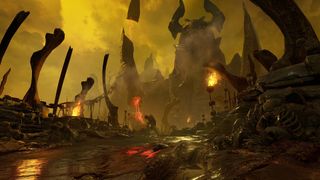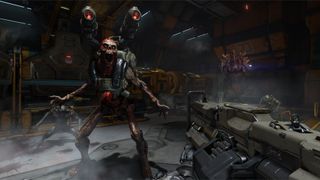Doom hands-on: teaching old demons new tricks

Double-jumping, another new element for the Doom series, was added in an effort to give the game some additional verticality and to provide the player with more movement options. The idea to include it came early, within the first six months of development, shortly after the glory kills were first conceived of. The addition of these elements is when the game really began to really feel like Doom for Marty Stratton, which is interesting, because not only are they new features but their roots lie in a game id Software doesn’t really like to talk about:
Doom 4. Doom 4, referred to as ‘Call of Doom’ after some footage leaked earlier this year, was in development for several years before it was decided, sometime in 2011, that a major change in direction was needed. “I think it was a good game,” Stratton says. It just wasn’t Doom. Nor was it completely thrown out when development began on the current version of the game.
“It’s easy to say ‘we scrapped all that’, but that’s never the case. You are always a collection of the things you’ve done in the past, including stuff that you decide to move away from.” There was a strong melee combat element in Doom 4, and Stratton says salvaging it eventually led to the creation of the glory kill system.
If anything slows modern shooters down, it’s probably all the extra components that have been tacked on over the years. Crafting systems, collectibles, and roleplaying elements such as those complicated skill trees that lead to long moments agonising over where to spend XP. While unwilling to discuss the specifics, Stratton confirmed that Doom will include some RPG elements, but he sees them working differently than they do in other shooters.

“We’re not doing a massive amount of skill-tree-ish type things. That doesn’t feel like really what Doom is. But certainly, making your guns cooler and more powerful or more functional based on the enemies you’re fighting, and making your character more functional and effective, is a big part of what we’re doing.”
He also insists these upgrades won’t just be tied to the weapon mods shown in the trailer, and won’t be the kind of incremental stat boosts common among other shooters. “We make them meaningful. It’s kind of a philosophy of our design team that if I’m gonna give you something, I’m gonna make it feel like I really gave you something, as opposed to these little niggly things that just kind of feel like you have to grind for.” To demonstrate, he rocks back in his chair as if something incredible has just appeared in his hands. “Whoah! I got this badass new capability!”
The weapon mods, he says, are good example of what he’s talking about. “They’re really effective, and you can upgrade them, and you can upgrade them in pretty effective ways, and make yourself a pretty good badass by the end of the game.”
The biggest gaming news, reviews and hardware deals
Keep up to date with the most important stories and the best deals, as picked by the PC Gamer team.
Modding is nothing new to Doom games, nor has it gotten old: the original Doom is still being modded today, over 20 years after its release. With SnapMap, a utility built right into Doom that allows players to piece together their own maps and game modes, id wanted to remove the barriers to entry. And, while it’s meant to be easy for beginners, it doesn’t mean more serious modders and programmers won’t be able to create more complicated mods from the ground up.

Chris started playing PC games in the 1980s, started writing about them in the early 2000s, and (finally) started getting paid to write about them in the late 2000s. Following a few years as a regular freelancer, PC Gamer hired him in 2014, probably so he'd stop emailing them asking for more work. Chris has a love-hate relationship with survival games and an unhealthy fascination with the inner lives of NPCs. He's also a fan of offbeat simulation games, mods, and ignoring storylines in RPGs so he can make up his own.
Most Popular



